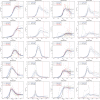Modelling national HIV/AIDS epidemics: revised approach in the UNAIDS Estimation and Projection Package 2011
- PMID: 23044436
- PMCID: PMC3512428
- DOI: 10.1136/sextrans-2012-050637
Modelling national HIV/AIDS epidemics: revised approach in the UNAIDS Estimation and Projection Package 2011
Abstract
Objective: United Nations Programme on HIV/AIDS reports regularly on estimated levels and trends in HIV/AIDS epidemics, which are evaluated using an epidemiological model within the Estimation and Projection Package (EPP). The relatively simple four-parameter model of HIV incidence used in EPP through the previous round of estimates has encountered challenges when attempting to fit certain data series on prevalence over time, particularly in settings with long running epidemics where prevalence has increased recently. To address this, the most recent version of the modelling package (EPP 2011) includes a more flexible epidemiological model that allows HIV infection risk to vary over time. This paper describes the technical details of this flexible approach to modelling HIV transmission dynamics within EPP 2011.
Methodology: For the flexible modelling approach, the force of infection parameter, r, is allowed to vary over time through a random walk formulation, and an informative prior distribution is used to improve short-term projections beyond the last year of data. Model parameters are estimated using a Bayesian estimation approach in which models are fit to HIV seroprevalence data from surveillance sites.
Results: This flexible model can yield better estimates of HIV prevalence over time in situations where the classic EPP model has difficulties, such as in Uganda, where prevalence is no longer falling. Based on formal out-of-sample projection tests, the flexible modelling approach also improves predictions and CIs for extrapolations beyond the last observed data point.
Conclusions: We recommend use of a flexible modelling approach where data are sufficient (eg, where at least 5 years of observations are available), and particularly where an epidemic is beyond its peak.
Figures



References
-
- UNAIDS Report on the global AIDS epidemic 2010 Geneva, UNAIDS, 2010.. http://www.unaids.org/globalreport/global_report.htm
-
- The Joint United Nations Joint Programme on HIV/AIDS (UNAIDS) Reference Group on Estimates, Modelling and Projections Improved methods and assumptions for estimation of the HIV/AIDS epidemic and its impact: recommendations of the UNAIDS reference group on estimates, modelling and projections. AIDS 2002;16:W1–14 - PubMed
Publication types
MeSH terms
Grants and funding
LinkOut - more resources
Full Text Sources
Medical
